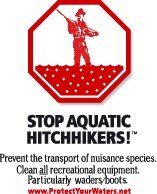NEW ZEALAND WHIO
TWO-TIMED
TWO-TIMED
 .. From Protect Your Waters comes a note about Didymo and it's spread in New Zealand. The diatom has been discovered in the world fly fishing destination-river Karamea, in Kahurangi National Park.
.. From Protect Your Waters comes a note about Didymo and it's spread in New Zealand. The diatom has been discovered in the world fly fishing destination-river Karamea, in Kahurangi National Park... The saga of threats to the Blue Duck is an example of "unintended consequences."
.. Rabbits, introduced to New Zealand became a pest. The stoat, (ermine,) was introduced to control the rabbits. The ermines found native ducks easier
 to catch and eat.
to catch and eat... The native Whio, (Blue Duck,) is endangered and now being threatened by Rock Snot, (Didymosphenia geminata,) in addition to the stoats.
.. This double threat from invasive species is a classic example of the exponential threats facing native species around the world.
.. The Scottish Author knew it well:
Oh what tangled webs we weave
When first we practice to deceive.
 .. It's not good to fool with Mother Nature.
.. It's not good to fool with Mother Nature... The same kind of threats face many species in Yellowstone National Park: fish and others. Our "deception" is improving all the time.
.. Early on, Victorians, Sportsmen, and Yellowstone Park Managers introduced exotic fish into the rivers of the park. The fish brought fishers. Fishers brought other invasive species.
.. Now Yellowstone's native Cutthroat Trout are disappearing through predation and interbreeding. Rainbow Trout, Brown Trout, and Lake Trout are the primary culprits at present. The New Zealand mud snails, Didymo, and other world travelers are threats looming on the near horizon.
 .. Fishing has grown, (though not recently,) to invade all fishable waters. It is a pastime that unthinkingly - or innocently - believes that it is about the fish.
.. Fishing has grown, (though not recently,) to invade all fishable waters. It is a pastime that unthinkingly - or innocently - believes that it is about the fish... Rivers, lakes, ponds, oceans, and the other waters that contain the fish are usually secondary in the thinking process of fishers. The ecology of the fish and its environs are way down the list of concerns and conversation. This has got to change if fishing is to continue in our national parks.
.. Rock Snot is at the south entrance to Yellowstone National Park. The threat is real and the diatom will probably be in the rivers within the park in the next year or two. It may be there now - unnoticed by fishers and managers alike.
.. For information about the hybrids in Montana's fishery visit: Trout Conservancy Of Montana. For information about Rock Snot just use your search engine.





.jpg)



